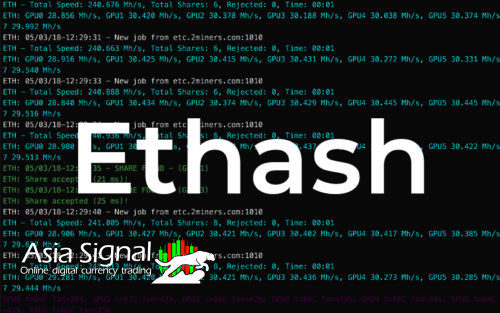Understanding Ethash: The PoW Algorithm Powering Ethereum
In the ever-evolving landscape of cryptocurrencies, Ethereum stands out as a pioneer in smart contracts and decentralized applications (DApps). Behind the scenes of this groundbreaking platform lies Ethash, the Proof of Work (PoW) algorithm that drives Ethereum's blockchain network. In this article, we delve into the intricacies of Ethash, its significance in the crypto space, and its role in maintaining the integrity and security of the Ethereum network.

What is Ethash?
Ethash is a PoW algorithm specifically designed for Ethereum mining. It serves as the backbone of Ethereum's consensus mechanism, ensuring the validity of transactions and the creation of new blocks on the blockchain. Ethash was introduced as part of Ethereum's vision to establish a decentralized, censorship-resistant platform for executing smart contracts and DApps.
How Does Ethash Work?
At its core, Ethash relies on complex mathematical puzzles that miners must solve to validate transactions and add new blocks to the Ethereum blockchain. Unlike traditional PoW algorithms that primarily rely on computational power (hash rate), Ethash introduces an element of memory-intensive calculations.
Miners participating in the Ethereum network must utilize a significant amount of memory (RAM) alongside computational power to solve these puzzles efficiently. This design choice was made to prevent the dominance of specialized mining hardware known as ASICs (Application-Specific Integrated Circuits) and promote a more decentralized mining ecosystem.
The Significance of Ethash in Ethereum
Ethash plays a vital role in maintaining the integrity and security of the Ethereum network. By requiring miners to use memory-intensive calculations, Ethash effectively levels the playing field, allowing individuals with standard GPUs (Graphics Processing Units) to participate in mining and contribute to the network's security.
Furthermore, Ethash mitigates the risk of centralization that often accompanies the proliferation of ASIC mining hardware. Instead of favoring those with access to specialized and expensive ASICs, Ethash empowers a broader community of miners, fostering decentralization and resilience against potential attacks.
Challenges and Future Developments
While Ethash has proven to be effective in achieving its goals, it is not without its challenges. As Ethereum continues to grow in popularity, the network faces scalability issues and rising transaction fees. These challenges have led to discussions around transitioning Ethereum from PoW to Proof of Stake (PoS) consensus mechanism through Ethereum 2.0 upgrades.
The transition to PoS, also known as Ethereum's Serenity upgrade, aims to address scalability concerns and reduce the environmental impact of mining. While Ethash will continue to operate during the transition phase, its long-term role in Ethereum's consensus mechanism remains uncertain.
Conclusion
Ethash stands as a testament to Ethereum's commitment to decentralization, security, and inclusivity. As the backbone of Ethereum's PoW consensus mechanism, Ethash has played a crucial role in establishing Ethereum as a leading platform for decentralized applications and smart contracts.
While the future of Ethash may be uncertain amidst Ethereum's transition to PoS, its legacy as a pioneering PoW algorithm in the crypto space will endure. Whether Ethash continues to evolve within Ethereum or paves the way for new innovations, its impact on the world of cryptocurrencies will be felt for years to come.
asiasignal has collected the best crypto signals leaks for you

















Comments